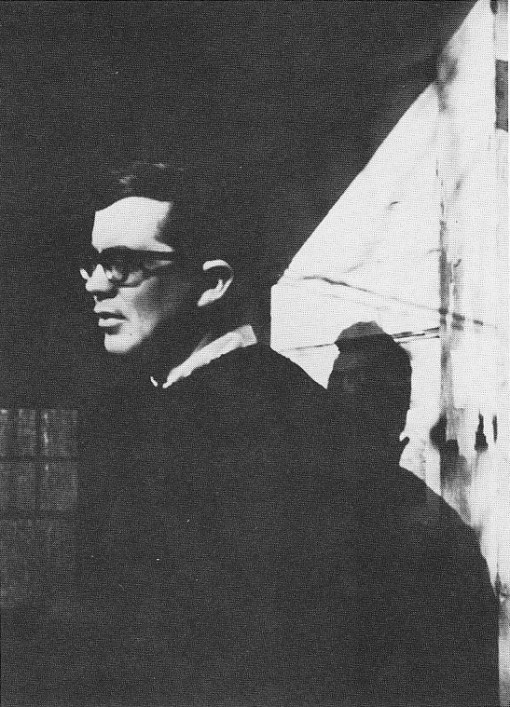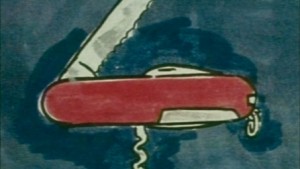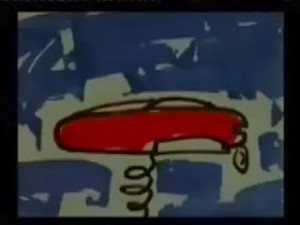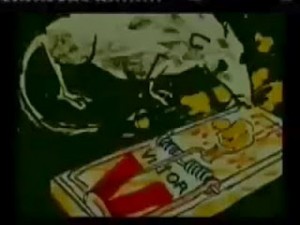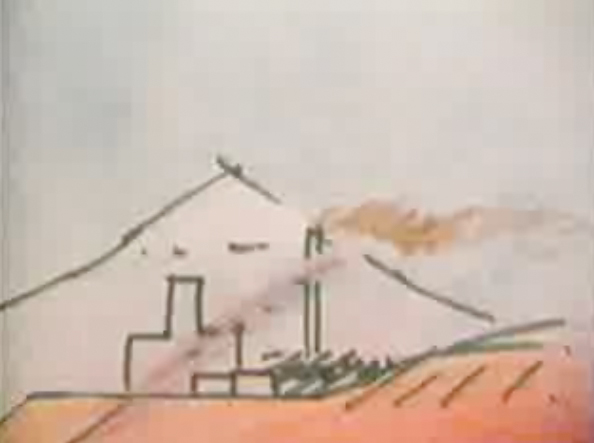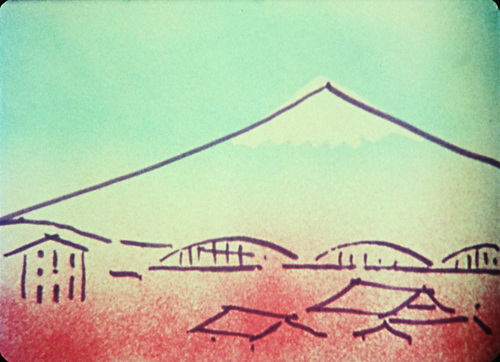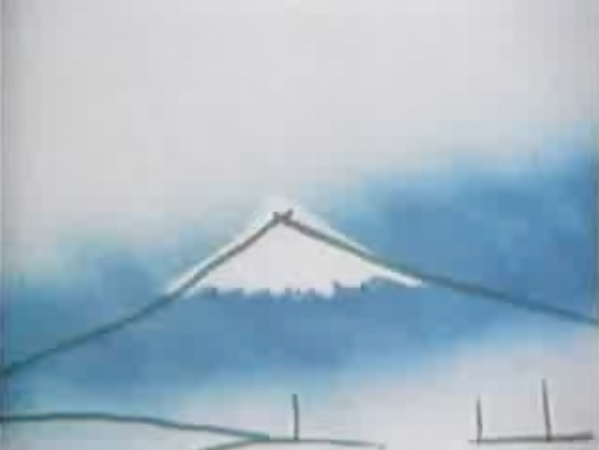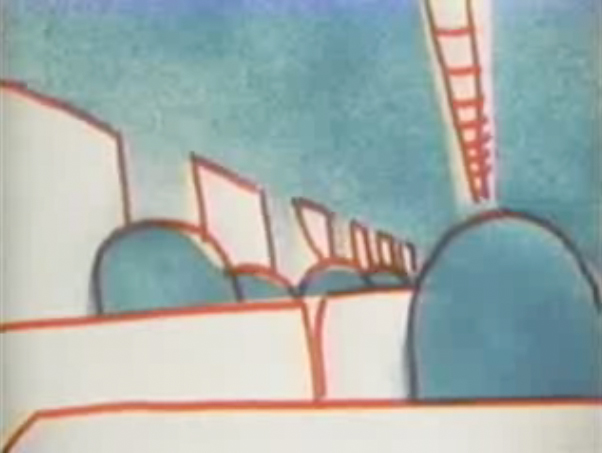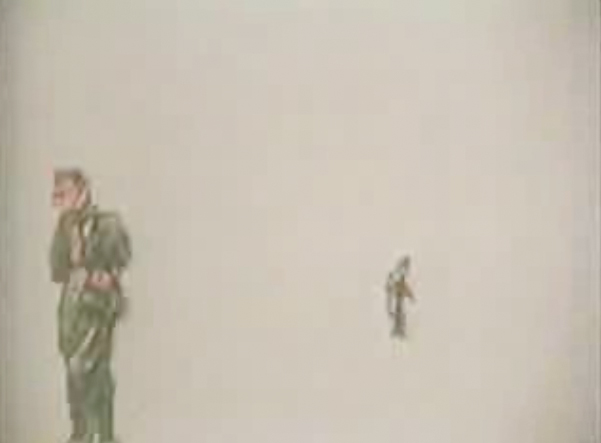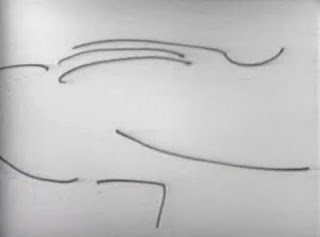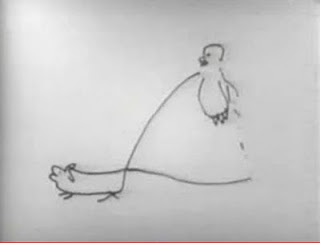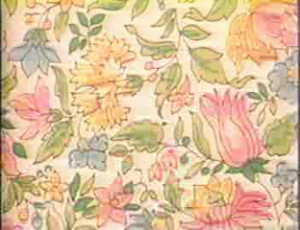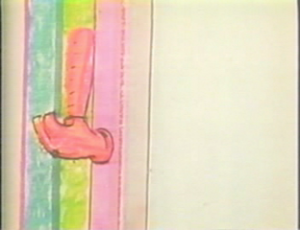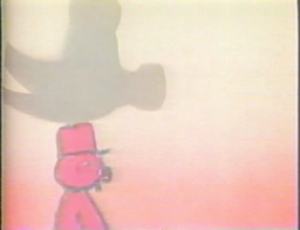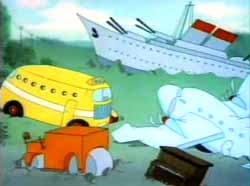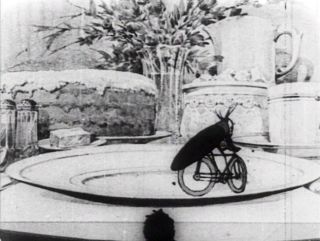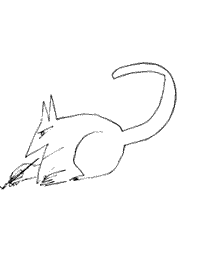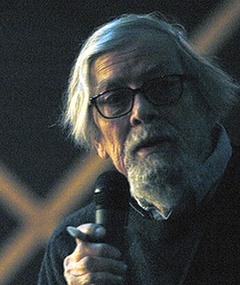A chapter from Film: The Front Line 1983.
All the major recent films of Robert Breer, an American who spent a crucial decade in Paris (1959-1969), are available in this country. But considering the fact that they’re independent animation, and that Breer is a one-man industry and not a Hollywood studio, they might as well be on the moon. They clearly inhabit a ghetto even more confining than that of the “foreign film,” because most critics lack an apparatus for dealing with them; hence, they find it easier to pretend that these works don’t exist. As uncontroversial as it might appear to be in most contexts, it is probably not irrelevant to note that when one of Breer’s most recent films, the characteristically brilliant Swiss Army Knife with Rats and Pigeons (1980) was screened at a New York Film Festival press show in 1982, it was rudely and audibly (if inexplicably) hissed. And candor compels me to admit that although — perhaps even because — Robert Breer impresses me as the key figure in avant-garde animation, my task in this book would be a good deal simpler if I too could pretend that he doesn’t exist, for the challenge of his work is precisely its capacity to reveal the inadequacy of any criticism that attempts to describe it — the challenge that can often keep the very best new avant-garde work either ignored (the standard journalistic ploy) or dealt with only circumspectly (the standard academic ploy).
To represent my own dilemma, let me reach for a device which seems somewhat compatible with Breer’s own sketchbook methods — namely, transcribing my own disconnected notes on a screening of Fuji (1974) which I attended almost three months ago. The point of this exercise is not to show off my tentative scratchings as if they were intrinsically interesting, but rather to demonstrate the impossibility of notating a film in progress whose very shape and experience are predicated on nonstop transformations. Every italicized passage in parenthesis, I should stress, represents an afterthought and addition made to correct or amplify a previous impression, usually a few seconds later. Each of these revisions, moreover, had to be made while still other transformations were occurring, making it literally impossible to write anything without missing something. Hence even the generalities that are set down here, modest as they are, were arrived at only through strenuous, uphill effort:
Sound of hammer on anvil (train sounds).Live-action is visible through train windows.Changing colors, overlapping sketches (of scenes and figures with shifting colors).Sections of black leader between each section.Fuji changing from shifting perspective of train windows.Pixillated red blob (different and changing shapes) appears over Mt. Fuji, like red circle on the Japanese flag.
Three-dimensional spinning shapes that undergo constant metamorphoses. Then: single frames (flash-frames) of objects and shapes coincide with a slower train rhythm (that gradually accelerates). Then still shots of Fuji (animated) with the same steady train noises (which persist longer than the visuals, over black leader at the end).
At the very best, some of this may correspond to a rough form of rhythmical notation, but conceptually it tends to establish itself in quicksand. In a context so slippery that the sound of a hammer on an anvil can quickly “become” that of a train, when a moving blob becomes too amorphous to become even a blob, and something can’t get slower without getting faster again — and even a supposedly still shot becomes animated — what anchor of discernible meaning, content or formal pattern can possibly be established by the hapless journalist, note book poised in hand?
Rather than attempt to answer such a rhetorical question abstractly, let me turn to the confident and [apparently] accurate description of the same film by Lucy Fisher, evidently with a little more time, space, and information on her hands, writing for a Museum of Modern Art catalog supplement:
Fuji is a work that represents a further stage in the development of Breer’s use of the rotoscope technique. The film constitutes an abstract recreation of the experience of a train ride past Mt. Fuji in Japan. Breer characteristically mixes modes of representation. In addition to rotoscope imagery he uses live-action footage and simple line drawing, and manages to shift between them with a fluidity that blurs perceptual distinctions. In abstracting the original photographic material, Breer emphasizes its compositional form. Mt. Fuji is a giant triangle and the passing scenery a series of rectangles punctuated by the vertical lines of electricity poles. Fuji transforms the visual imagery of a train ride into an experience of kinetic geometry.
The first Breer film I had on opportunity to become familiar with was A Man and His Dog Out For Air (1957), which was shown with Last Year at Marienbad during the latter’s initial run at Carnegie Hall Cinema in 1962. Returning to Marienbad again and again, I inadvertently wound up seeing the two-minute Breer short just as many times over that nine-month period. I certainly didn’t mind seeing it so often, but it never would have occurred to me, at age 18, that there was any discernible formal relationship between the dazzling spatio-temporal displacements and transitions being affected by Alain Resnais and Alain Robbe-Grillet and the constantly shifting line drawing of Breer, which oscillates at regular intervals between representation and abstraction. (If memory serves, the drawing resolves itself aurally and visually into the title subject only in the film’s closing seconds.)
As a plastic artist, of course, Breer was better equipped to deal with abstraction in much more literal (i.e., non-representational) a fashion than Resnais or Robbe-Grillet could have possibly attempted (being obliged to work, in their case, with actors, sets, costumes, dialogue, plot and other narrative trappings). Unfortunately or not, most of the arts haven’t developed in any true parallel fashion, and for someone like myself whose background had more to do with literature than with painting or sculpture, Resnais and Robbe-Grillet were much more obviously innovators than Breer, a mere fancy cartoonist in my eyes. The same year, however, Breer published a statement in Film Culture (No. 26), which begins, “Hurray for a formless film, a non-literary, non-musical, picture film that doesn’t tell a story, become an abstract dance, or deliver a message. A film with no escape from the pictures. A film where words are pictures or sounds and skip around the way that thoughts do. An experience itself like eating, looking, running, like an object, a tree, building, drips, and crashes. A film that instead of making sense is sense. Because it’s a picture film it might combine reason and kite flying and torpedoes and golf. People can talk in it. It can turn on and turn blue and turn off.”
According to Sandy Moore’s helpful monograph on Breer (Film in the Cities, 1980), the filmmaker “explains that he feels numbers correspond to abstraction, letters to figuration” in the titles of his films. I haven’t seen Rubber Cement, Breer’s 1975 film, which reportedly uses color xeroxing techniques, but 77, made two years later, does seem in retrospect like a film where abstraction predominates, despite a few recurring objects (e.g., a briefcase, a circular electric fan, a tricycle, a desk lamp), most of which rotate 360 degrees before collapsing back into abstract lines and shapes.
[One can watch this film here: https://vimeo.com/792169952]
The extraordinary maelstrom of movement and detail found in all of Breer’s recent work gives one the impression that each shorts generates enough visual material to stock a narrative feature, pressed into a time frame that’s roughly only one-twelfth as long – making one realize how much substance there may be behind Greg Ford’s argument that there are more short masterpieces than ones of feature length. (The purist aesthetic preference for the six-to-ten-minute animated film over the live-action feature is analogous in certain respects to Edgar Allan Poe’s defense of the story and poem that are brief enough to be consumed in a single sitting, over the more variable vicissitudes of the book-length work.)
What seems most prodigious about Breer’s recent work, making it far more than a self-reflexive version of (say) Norman McLaren, is the absolute economy of gesture, the evocative power of the sketch -– comparable, all things considered, to aspects of Finnegans Wake and the late work of Samuel Beckett –- and the profusion of content within a relatively small area that this makes possible. In 77, all the fluttering fragments of line and design that rush past the consciousness, like the increasing vibrancy and brightness of the colors, point to a festival of ideas that are appropriately offset by the simplest of noises on the soundtrack, like the sound of wind. These ideas inhabit a field that might be regarded as philosophical as well as perceptual; as Fred Camper writes (in program notes for the Millennium in 1979), “The animated abstract shapes have a vivid, suggestive, almost anthropomorphic life; they have many of the qualities of representational objects occur with a kind of irrelevant (in a narrative sense) randomness that makes them less narrative, more purely moving forms, than similar objects have been in earlier Breer films.” This shifting, ambiguous relationship between the abstract and concrete lends an additional quirky life to Breer’s perceptual transformations.
LMNO –- conceivably the best of all of Breer’s films to date – has more to do with figuration, according to Breer’s formulation regarding titles with letters or numbers. (As he put it in his interview with Jim Trainor in the Spring 1980 Upstart, “Letters are more literary and therefore more representational.”) This becomes clear right away as the title letters are intercut with a flurry of fish swimming past the frame lines, which are made all the more literal through the associative chain established by a snippet of Schubert’s Trout Quintet heard on the soundtrack, along with footsteps – which continue over a profusion of other shapes, colors, and objects, including the title letters again.
Indeed, as Elena Pinto Simon has pointed out in a review of the film (Millennium Film Journal, Nos. 4/5, Summer/Fall 1979), LMNO extends representation to the point of becoming “a play on the idea of narrativity – the film abounds in anecdotes and small stories that erupt, dance briefly and brilliantly before our eyes, and disappear only to evolve into another brief narrative passage.” Consequently, certain objects that recur in the film –- a biplane traversing the frame, a hammer, an aerosol spray can, a faucet, a milk carton — take on the status of narrative characters in certain respects (along with a jogger who keeps coming back, almost as regularly as the jogger in Resnais and Mercer’s Providence –a literal character). And the dazzling sweep of Breer’s rich, orchestral visual music here becomes expanded from mere shapes and objects into small dramatic situations and mini-plots: a croquet game, which follows the progress of a croquet ball through a wicket while it changes color, proceeds in separate shots from different angles like a classically edited découpage; a subsequent sequence of events recreates a pratfall out of silent slapstick with a banana peel, a knife, a milk carton, and a man who slips on the banana peel before splitting in half (which, incidentally, is what happens to the croquet ball at the conclusion of the previous sequence).
While it is usually standard operating procedure to oppose Breer’s sort of animated work with Hollywood’s, the fact remains that the rapid flood of images succeeding one another towards the beginning of LMNO -– a snapshot of a building, a bathtub, a tennis racket, a boat, a plane, a target, several trees –- is not all that different in effect from the surrealist array of successive objects which drop from the sky and crush a crazed alley cat in Tex Avery’s Bad Luck Blackie. Both parody the cumulative processes of narrative itself; the fact that Avery does this in a context that veers more conventionally towards narrative makes the slam-bang approach seem only slightly more hyperbolic. No less Averylike, one should add, is the self-referentiality of a sequence involving a rotating 16mm movie projector and a filmstrip full of moving images that exposes the film process on several interlocking levels of paradox at once.
That Breer himself is fully conscious of working within an established tradition of animation is made clear in many of his statements. Sandy Moore’s monograph, for instance, points out that “the little blue self-pitying figure” who “suffers several deaths” in LMNO is a reference to the figure of the policeman in Emile Cohl’s films, while an abstract sequence towards the end of TZ, Breer’s subsequent film, actually has its origins in the cartoon insects on bicycles in Windsor McKay’s Bug Vaudeville. And yet the fleeting quality of all his inventions is such that one begins to see such references existing on the same plane as the photographed and drawn images of the Tappen Zee Bridge (visible from Breer’s apartment in Nyack, New York) at the beginning of TZ — material that exists mainly to be transformed, that is, banal, everyday material that happens to be on hand. (Within the same film, a phone becomes a car, which becomes in turn a cat in a car -– an almost rebus-like progression that faintly suggests Saul Steinberg’s conceptual conceits.)
The artisanal integrity of Breer’s technique mainly involves drawing on thousands of unruled white 2” x5” index cards over a lightbox. This makes it possible for him to include anything he wants in his ongoing stew –although how and when he includes something seems anything but arbitrary. Working out what formal necessity means in a Breer film would be a useful activity – like taking apart a clock to see how it ticks, and one would like to see it done.

